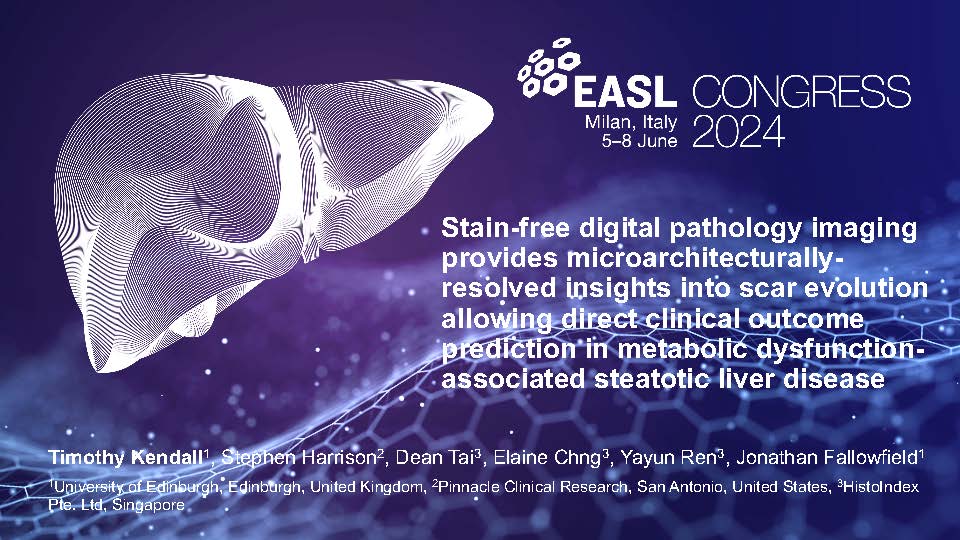Presentation ID: OS-087, EASL Congress 2024
ABSTRACT
Authors: Timothy Kendall1, Stephen A. Harrison2, Dean Tai3, Elaine Chng3, Yayun Ren3, Jonathan Fallowfield1
1. University of Edinburgh, Edinburgh, United Kingdom
2. Pinnacle Clinical Research, San Antonio, United States
3. HistoIndex Pte. Ltd, Singapore, Singapore
Background and Aims: Fibrosis stage in metabolic dysfunction-associated steatotic liver disease (MASLD) is associated with increased mortality and liver-related events. Direct prediction of outcomes from tissue has not been possible due to the lack of a suitable event-rich cohort. Using an unstained section from biopsies of the SteatoSITE cohort has allowed quantification of extracellular matrix features that are predictive of clinical outcome but unapparent to human observers.
Method: Sections from 452 SteatoSITE biopsies were randomized into train (300) or test (152) sets and imaged using second harmonic generation/two-photon excitation fluorescence microscopy (SHG/TPEF). Using sequential feature selection, 5 of 184 fibrosis parameters were chosen and linear regression used to construct individual indices for risk of all-cause mortality and hepatic decompensation. Using the test set, Kaplan–Meier analysis, with death a competing risk for decompensation, and Cox proportional hazards modelling was performed. The predictive power of the risk indices was compared with assigned NASH-CRN fibrosis stage (F0/1/2 v F3/4) and stain-free imaging derived qFibrosis stage (qF0/1/2 v qF3/4). Previous indices were established using a training set of 294 biopsies with leave one-out cross-validation.
Results: Previously established all-cause mortality and hepatic decompensation indices had greater predictive power than either NASH CRN or qFibrosis stage. New indices generated with these train and test sets from an extended MASLD cohort also outperformed existing predictive metrics. The new all-cause mortality index had greater predictive power (>0.14 vs. </= 0.14, hazard ratio (HR) 4.49, 95% confidence intervals (CI) 1.5-13.38) than qFibrosis-derived stage (HR 3.07, CI 1.3-7.26) or NASH-CRN fibrosis score (HR 3.41, CI 1.43 8.15). The new hepatic decompensation index had greater predictive power (>0.31 vs. </= 0.31, HR 5.96, CI 2.92-12.14) than qFibrosis derived stage (HR 3.59, CI 1.79- 7.2) or NASH-CRN fibrosis score (HR 3.65, CI 1.81-7.35). Parameters used in separate indices were related to extracellular matrix features in portal tract, periportal, and zone 2 regions.
Conclusion: We show that individual indices composed of microarchitectural features quantified by stain-free imaging have greater predictive value for all-cause mortality and liver-related events than ordinal fibrosis scores. These new indices may be used for more nuanced participant stratification or more meaningful endpoints in trials. To establish a definitive link between microarchitectural features at baseline, their modification following drug treatment, and associated clinical outcomes, it is essential to incorporate validation within a prospective study.

